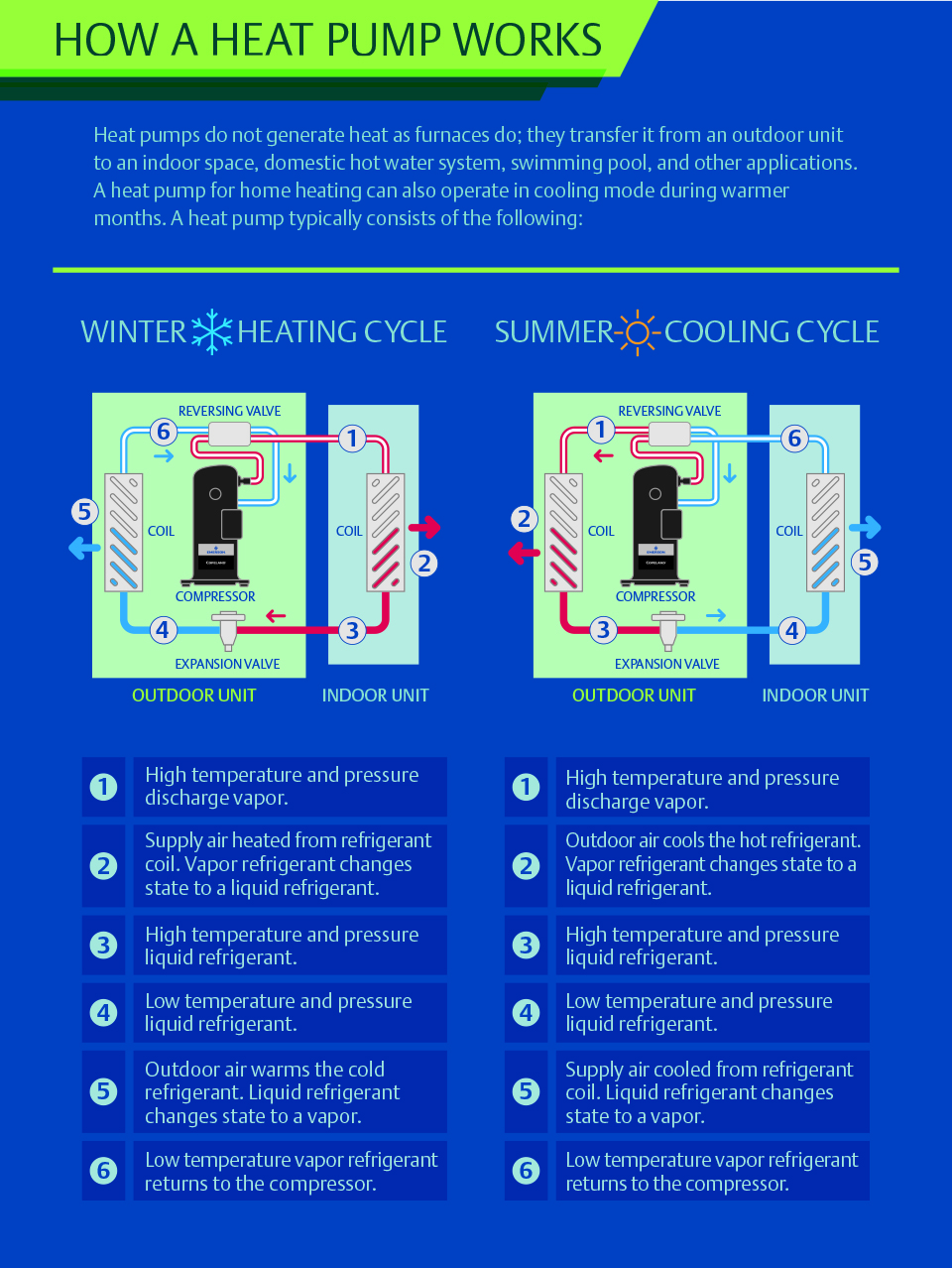*On June 1, 2023 Emerson’s Climate Technologies business became a new standalone company – Copeland. Though our name has changed, we are building on more than a century of HVACR innovation and industry leadership, and Copeland continues to offer the same products, industry stewardship, and learning opportunities you’ve grown to trust. Information found on this webpage posted before June 1, 2023 may contain our old name or branding, but you can be at ease knowing it was created with the knowledge and expertise of Copeland.
When it comes to heating and cooling homes and businesses, there’s a solution that saves consumers money and makes a difference for the planet: the heat pump.

A heat pump system heats a home or building using electricity, instead of burning fossil fuels like boilers and furnaces. While traditional heating systems generate heat, heat pumps simply transfer it. In the winter, heat pumps capture heat from the outside, even in cold weather, and release it inside. In the summer, heat pumps reverse the flow, capturing heat from inside a building and releasing it outside, thus creating a cooler indoor space.
There are three main types of heat pumps – air source, water source and geothermal, which differ in where they collect heat – from the air, water, or the ground outside a building, respectively. And while temperature regulation of interior spaces is the most prominent use of the technology, heat pumps can also be used as water heaters for homes, buildings, and pools.

AN EFFICIENT AND SUSTAINABLE SOLUTION
When it comes to heating and cooling, the commercial and residential sectors are responsible for 13% of total U.S. greenhouse gas emissions (GHG). These emissions from businesses and homes are primarily due to fossil fuels burned for heat. Indirect emissions from electricity production account for more than a quarter of the country’s emissions as more than half of U.S. electricity comes from burning fossil fuels. As the country begins to shift electricity production to less carbon-intensive natural gas and renewables, heat pumps, which use electricity, will offer a significant opportunity to reduce GHG emissions.
Now being installed in approximately 40% of new U.S. homes, heat pumps can offer home and business owners a more efficient solution to heat and cool their spaces, potentially saving on their energy costs and reducing their greenhouse gas emissions. In fact, over the last two decades, heat pumps have gained traction with consumers in milder climates, in new home/building construction, and those looking for more cost-effective technology or who are concerned about their carbon footprint.
But despite this steady growth in new construction, with technology that has been available for decades, there have been challenges in delaying broader adoption of heat pumps – chief among them are concerns about performance in colder climates, cost of installation and operation, inconsistencies in policy and incentives, and the need for skills and sales training for newer heating, ventilation, and air conditioning (HVAC) technicians.
CHALLENGES TO WIDESPREAD U.S. HEAT PUMP ADOPTION
- Cold Climate Technology
Historically, air source heat pumps have been used mainly in buildings and homes located in warmer climates, where the technology is able to easily keep pace with narrower temperature changes. But current heat pump technology does not function as efficiently in colder climates with lower minimum ambient temperatures. Today’s heat pumps are typically sized based on the maximum cooling capacity requirements, and many systems can meet 100 percent of the space heating load that is required above 30°F. But when outdoor temperatures start to dip below 30°F, some form of supplemental heat is needed to meet the heating load on the home, whether electric or gas furnace. Currently, electric resistance heat is a less efficient form of heating which reduces the overall efficiency of the heat pump system, and gas furnaces are burning fossil fuels that impact environmental sustainability – limiting factors to widespread adoption in colder climates.
Potential Solution:
Initiatives like the U.S. Department of Energy’s (DOE) Residential Cold Climate Heat Pump Technology Challenge reflect ongoing efforts to promote technological advancements in ducted heat pumps. The DOE is partnering with top HVAC companies to accelerate the performance of cold climate heat pump technology by improving efficiency and capacity delivered at low ambient temperatures. Through this program, the DOE aims to develop new technology specifications for a high-performance cold climate heat pump that meets consumer needs while also launching pilot programs with partners to identify and alleviate installation challenges. As advancements are made in the residential market, they are expected to quickly transfer to commercial applications, accelerating adoption.
Copeland also continues to innovate its industry-leading compressor technology to enable more efficient, cold-climate heat pumps. With more than 200 million installations over 35 years, Copeland™ scroll compressors are the leading compression technology being used in heat pumps today. This high-performing, reliable compressor technology allows HVAC companies to expand the use of heat pumps to colder climates while enabling higher energy efficiency and a more comfortable experience for end users.
(Learn more about the engineering behind advancements in cold climate heat pump technology in our third installment of our Heat Pump Technology Series.)
- Installation and Operating Costs
Building infrastructure, natural gas vs. electric rates, and retrofit cost are issues limiting the broader adoption of heat pumps. Installation costs can be higher for existing buildings, where retroactively installing heat pumps can be difficult and require integration with existing systems. Although costs vary, retrofitting a heat pump in a building or home can sometimes cost more than it would to install or replace traditional fossil-fuel HVAC systems. Another dynamic is the trend of natural gas and electric rates and their impact on operating costs through electrification. In many locations across the U.S., natural gas prices remain low. Over time, this is projected to change with gas prices expected to increase more significantly than electric.
Potential Solution:
While the infrastructure updates often needed to add a heat pump can increase upfront costs, a whole-building approach can help owners to realize long-term savings. With operation cost the primary contributor to achieving the best efficiency, evaluating a whole building’s envelope by making improvements such as new windows and insulation, can help to maximize the heat pump investment. These improvements can work together to lower monthly utility costs, which can add up significantly over time.
Additionally, there are several utility and government incentives to help mitigate the higher upfront costs typically associated with heat pump installation. Many utilities are offering rebates for qualifying heat pumps and other energy efficient solutions. The Energy Efficient Home Improvement Credit offers a tax credit for 30% of installation costs on HVAC products that meet the highest CEE efficiency tier, including heat pumps. Additionally, the Inflation Reduction Act includes point of sale rebates for low- and moderate-income families and tax credits toward the purchase of higher efficiency heat pumps, designed to increase heat pump adoption in new and existing homes and buildings.
- Inconsistent Policies and Incentives
Policy sets the stage for energy efficiency and home improvement incentives available from federal, state, and local sources in a variety of forms: point of sale rebates, tax credits, grants, guaranteed loans, etc. Despite these varied options, inconsistent policies around fuel switching and dual fuel systems is a leading challenge to heat pump adoption.
Fuel switching: In the heating market, fuel switching is the act of changing from a primary fuel source, such as natural gas, to something else, such as electricity. Some policies may incentivize transitioning from a natural gas furnace to an electric heat pump, while others may prevent incentivizing from one fuel source to another – creating an inconsistent and unclear picture for consumers. In the U.S., for example, 23 states have no fuel switching policy in place, while 12 have policies that prohibit or discourage it, and 15 have policies supporting or encouraging fuel switching.
Dual-fuel systems: Another challenge is allowing fossil fuel for low ambient heating, also known as dual fuel or a hybrid system. Some incentives encourage a move toward all-electric immediately, while others allow for an alternate fuel source to ensure resiliency, enhanced economic benefit, and comfort in the event of extreme weather. Depending on the cleanliness of the grid power, a dual fuel approach may actually be less carbon intensive than an all-electric solution.
Potential Solution:
As the U.S grid continues to use more renewable resources and technology advancements are made – especially around heat pumps that operate efficiently down to extremely low ambient conditions, we expect decarbonization policies to become more unified, although there will still likely be some regional differences. In this transitional phase, as the nation strives to increase grid capacity and cleanliness, and the industry advances cold climate heat pump technology, consumers still need options to implement today to help move us toward a more sustainable world. Copeland fully supports decarbonization policies that will allow for that flexibility, including the use of dual fuel systems.
(Learn more about how policy, regulations and rebates will help to drive heat pump adoption in our second installment of our Heat Pump Technology Series.)
- Heat Pump Technician Skills Training
In the U.S., there is a shortage of trained HVAC technicians, with huge vacancies of unfilled jobs and a net loss of 8% leaving the industry each year. As more experienced service technicians begin to retire, newer technicians are coming into the industry and will need to be quickly trained on things like how to properly size and install heat pump systems.
Potential Solution:
Copeland has ongoing programs to support the training and development of next-generation skilled tradespeople, including a partnership with the National Coalition of Certification Centers (NC3), a career and technical training organization that supports skilled trade advancement. For more than 20 years, Copeland has also been a proud supporter of North American Technician Excellence (NATE), the nation’s largest non-profit certification organization for HVACR technicians. With employees who serve on the board, as well as on committees, the organizations collaborate on industry topics around field service and installation of HVACR equipment. Additionally, Copeland also provides additional training support through its Educational Services team with on-site training, virtual classrooms, and eCourses. Its recently launched HVACR Educator Resource platform provides industry educators access to tools, training, and educational materials to enhance learning for the next generation of HVACR professionals.
- Heat Pump Customer Sales Tools
To be able to sell heat pumps to customers, HVAC sales teams need to understand the advantages that these systems offer in terms of energy savings and comfort. It is critical to learn how to position upfront cost alongside the long-term value to upsell more sustainable solutions to the masses. To help offset upfront costs, salespeople also need to be aware of the types of rebates and incentives are available at both the local, state, and federal level.
Potential Solution:
To arm sales teams with materials to help sell to customers, Copeland provides resources like the recently launched Residential Heat Pump Rebate Finder, a valuable tool to help customers find cost-savings for more efficient, sustainable solutions.
Electrifying the Future
To achieve a more sustainable, electrification of heating applications, investment in grid infrastructure will be needed to enable broader heat pump adoption. But despite current barriers, we see strong tailwinds for broad heat pump adoption. The energy efficiency of heat pumps, technology improvements, government incentives, infrastructure improvements and consumer demand make heat pumps a clear part of achieving sustainable HVAC.
This is the first article in our Heat Pump Technology Series. In coming posts, we’ll go deeper into U.S regulatory and policy drivers, and advancements in cold climate heat pump technology.
Learn more at: https://copeland.com/en-us/sustainability/heat-pump-technology

Facility Health Score Insights Program Transforms Enterprise Maintenance
Leveraging refrigeration performance data drives food retail cost reductions. Maintaining proper...

8 proven strategies for rigorous cold chain management
Preparing for the approval and safe use of A2Ls in commercial refrigeration applications...
Protection for high-value shipments just got even better
We’re excited to announce the release of Copeland’s newest real-time tracker, the GO Real-Time...
